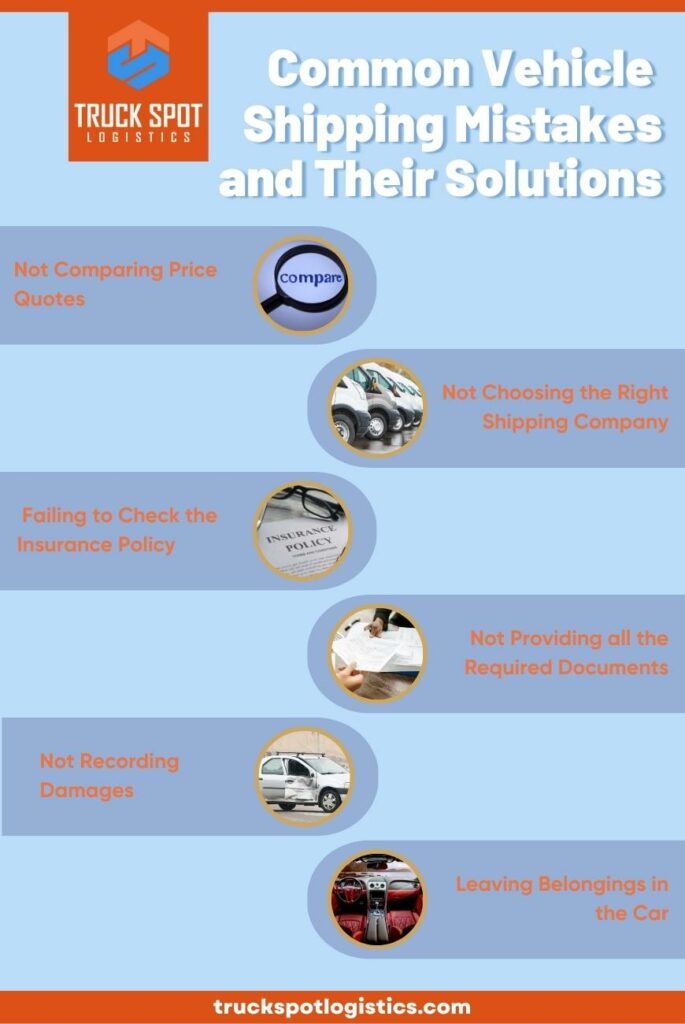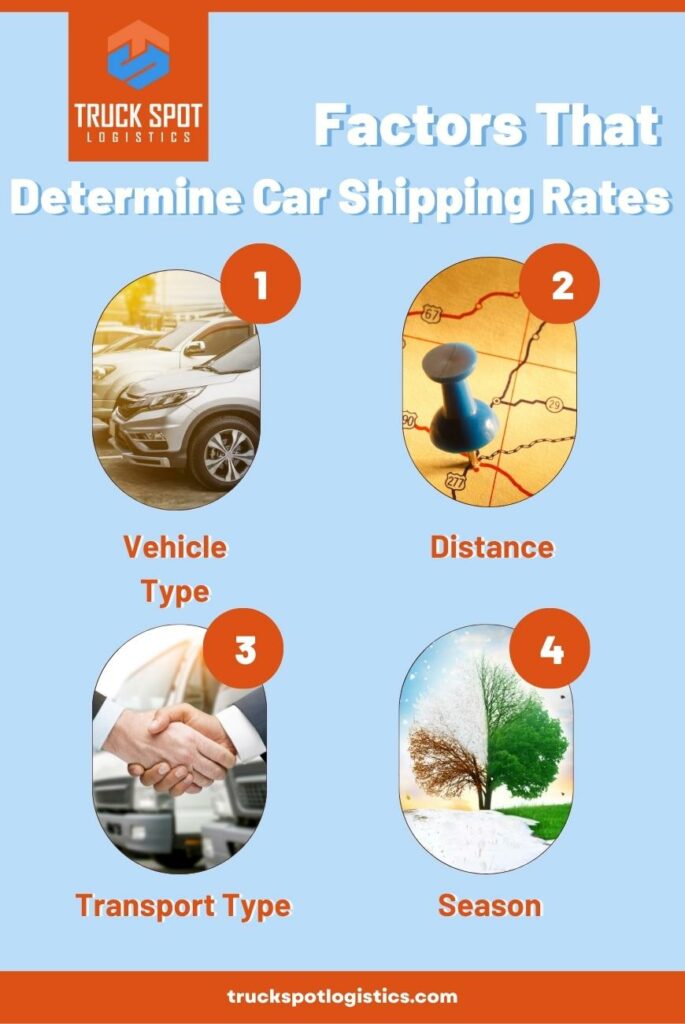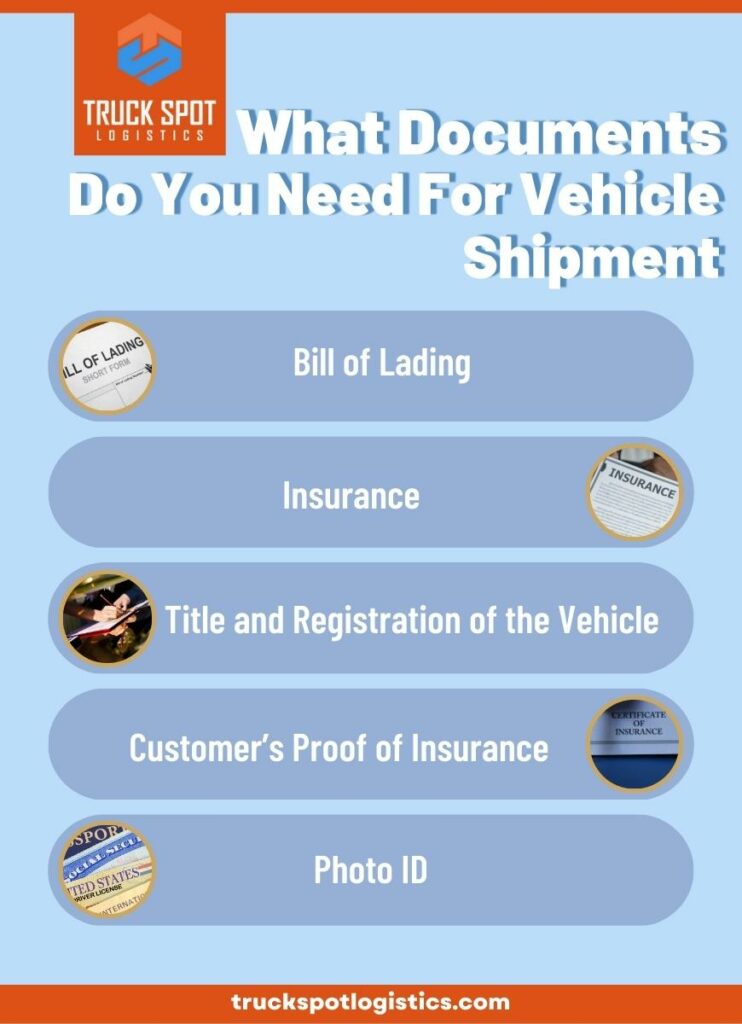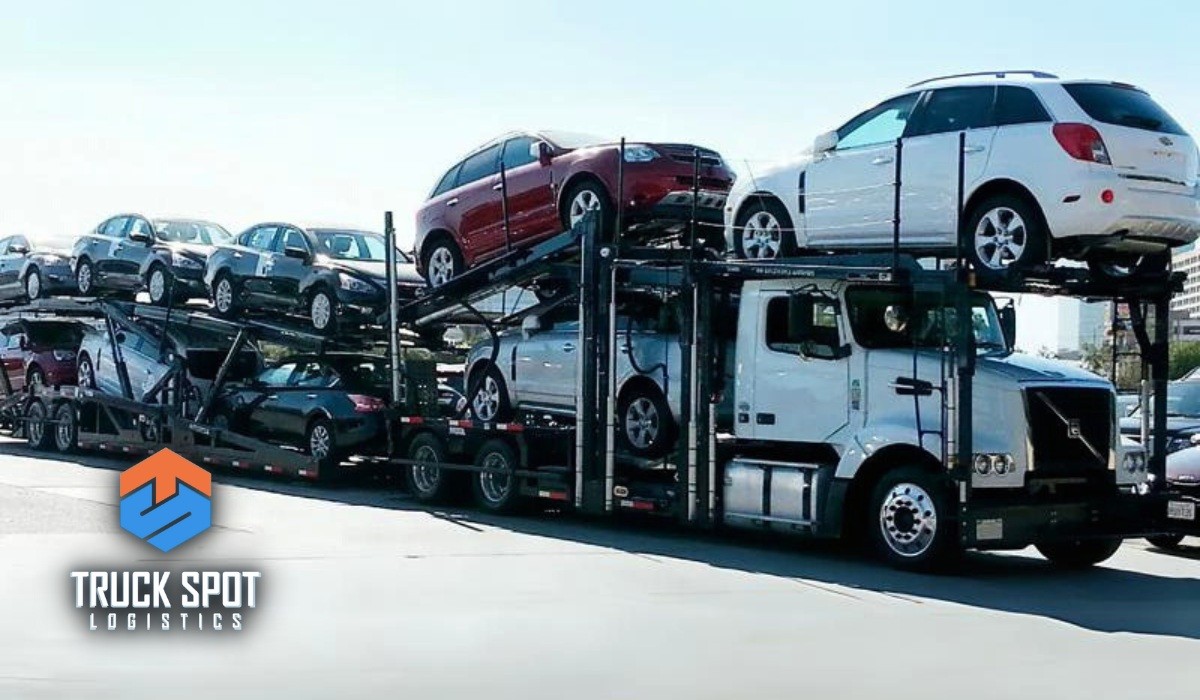Navigating the complexities of auto transport can be daunting, especially if you’re encountering common mistakes when shipping a vehicle. Whether you’re arranging the shipment of a family car, motorcycle, ATV, boat, truck, golf cart, RV, trailer, or heavy equipment across the US, knowing what mistakes to avoid is key to a hassle-free experience.
At TruckSpot Logistics, we understand the intricacies of auto transport and are here to guide you through the process. This article is designed to equip you with the knowledge to navigate the world of vehicle shipping smoothly, ensuring your prized possession arrives at its destination just as it left—safely and on time.
Common Vehicle Shipping Mistakes
and How to Solve Them
When it comes to shipping your vehicle, whether it’s your daily driver, a beloved motorcycle, or heavy equipment, steering clear of the typical roadblocks can save you time, money, and headaches. At TruckSpot Logistics, we’ve seen it all, and we’re here to share insider advice to keep your shipping experience as smooth as the open road. Here’s how to avoid mistakes when shipping a car and other vehicles.

Mistake #1: Not Comparing Price Quotes
When opting for any service, we all know it is wise to compare price quotes from various service providers. A common mistake people make when booking a shipping service is not checking with other shippers. Comparing only the price quotes is not necessary. When comparing two shipping service providers, you also compare their offerings, customer reviews, and much more for a detailed comparison of various price quotes, feel free to visit TruckSpot Logistics. Here, professionals will help you in comparing price quotes from top shipping companies in the business.
Mistake #2: Not Choosing the Right Shipping Company
The problem with many vehicle shippers in the US is that people often select the wrong service provider. A good parameter for identifying such a company is its low-price quote compared to the market rate.
To only have trust-worthy companies on your list, here are a few tips:
The shipper’s company must be registered with the Department of Transportation. Run a thorough background check to see the legitimacy of the company. You can do this by checking the reviews of the company. Talking to the representatives at a potential shipping company can be a great idea to look into what they are offering. Do the same with all the companies you have short-listed.
Mistake #3: Failing to Check the Insurance Policy
Almost all shipping companies offer some insurance coverage, but the individual policy varies everywhere. Many people fail to cross-check the insurance policy and its validation when booking shipping services. In terms of insurance, do not trust any quotes without proof. Or an even better option is to ask the company for insurance proof in the form of a certificate from the Department of Transportation.
Mistake #4: Not Providing all the Required Documents
Forgetting a key document can throw a wrench in the works faster than you can say ‘shipment delay.’ From the bill of lading to your photo ID, we’ll help you compile everything you need for a green light all the way. The Federal Motor Carrier Safety Administration provides a checklist of necessary documents for transport.
Mistake #5: Forgetting to Document Vehicle Condition
When documenting your vehicle’s condition, it is important that you correctly register all its damages. The shipping company often asks you to fill out a vehicle inspection form. Also, they physically inspect your vehicle and document its condition. You should always cross-check their report for accuracy. And simultaneously, if they missed any damage in reporting, do point it out. For self-record, you can also take pictures of different parts of your vehicle.
Mistake #6: Leaving Belongings in the Car
One of the most common mistakes people make when handing over their vehicle to the shipper is leaving behind personal belongings. Double-check the dashboard, seat pockets, and any other storage area your car has for any individual item.
Remember, the road to successful vehicle transport is paved with good intentions and even better preparations. Dodge these common vehicle shipping mistakes with TruckSpot Logistics by your side, and you’ll be cruising worry-free. Ready to ship? Let’s talk
Understanding Vehicle Shipping Rates
Costs and Influencing Factors
Embarking on the journey of shipping your vehicle, whether it’s a family sedan or a hefty RV, comes with its fair share of questions. “How much will it cost?” tops the list. It is impossible to give an exact quote without knowing the particulars of the vehicles and details of the preferred shipping method. Here are a few price quotes calculated for specific cars to specific destinations:
Factors Affecting the Shipping Cost
We all love a good deal, but when it comes to shipping your ride, the cheapest option might not always be the best route. Let’s demystify the factors that will affect your bottom line, so you can budget without the guesswork and avoid common vehicle shipping mistakes.

Vehicle Type
The make and model of your vehicle are more than just specs—they influence the space your vehicle occupies on a carrier and the care it requires. Shipping a delicate classic car? You might want an enclosed carrier for extra protection.
Distance
Distance of shipment is as important as vehicle type in terms of the cost of the shipment. Both are quite critical in deciding the price quote of freight. It is self-explanatory that the farther you ship, the more expensive it gets. Different companies have different distance policies. Most of them charge per mile. However, the rate of each mile decreases as the distance increases. So, a short distance is often cheaper, but the rate per mile is higher. On the other hand, the cost of long-distance might seem expensive, but it has a lower per-mile rate.
Transport Type
Generally, there are two types of transport vehicles: open and enclosed. The latter is significantly expensive. You can opt for enclosed transportation if the weather is unfavourable or you want to protect your vehicle from external factors. However, available transit is not as risky as it may sound in comparison.
Season
If you want to cut the shipment price, opt for off-seasons such as winters. But with this, keep in mind that shipping may take longer than usual, and some areas might have blocked roads and suspended shipment service. Summer is the peak season for shipping services, but the cost is higher.
Every vehicle’s journey is unique, and so is the cost. For a transparent, no-nonsense quote that puts you in the driver’s seat of the shipping process, holler at your friends here at TruckSpot Logistics. We’re here to help you navigate the road of vehicle shipping, sidestep car shipping problems, and get your vehicle where it needs to be without a hitch. Request your quote today and hit the road with confidence.
Necessary Documentation To Avoid Problems During Vehicle Shipping
We all know the feeling of missing a crucial piece of paper at the last minute—frustrating, right? To keep your vehicle shipping as smooth as the open highway, there’s some paperwork you just can’t skip. Here’s the lowdown on the essential documents you’ll need to sidestep common vehicle shipping problems and ensure your transport is on the up-and-up:

Bill of Lading
Think of the Bill of Lading as your vehicle’s passport for its travel. It’s a crucial document that records the condition of your vehicle pre- and post-shipment and serves as a binding contract. Before you sign off on this, give it a good read to make sure everything checks out.
Insurance
Your peace of mind on the road comes from knowing you’re covered. That’s where your insurance documentation comes in. It spells out what’s protected and to what extent. To steer clear of any shipping mishaps, review your policy and verify the details. If you need a primer on what to look for, here’s a resource that can help.
Title and Registration of the Vehicle
No one wants their vehicle to hit a roadblock in the shipping process. Your vehicle’s registration and title are like its identity card—they prove that it’s yours and it’s legit. Keep these documents handy; some shippers might want to see them to cross their t’s and dot their i’s.
Customer’s Proof of Insurance
This one is also a secondary importance document. Most companies do not check for any previous insurance proof when shipping a vehicle.
Photo ID
Just like you wouldn’t leave home without your driver’s license, don’t kickstart the shipping process without a valid photo ID. It ties you to the vehicle and the transaction, ensuring everything is above board.
Got everything on the list? Fantastic! You’re all set for a seamless shipping experience. If you’re feeling stuck or need a hand gathering your docs, give us a shout at TruckSpot Logistics. We’re here to help you navigate through the paperwork so you can avoid those all-too-common car shipping problems.
With these documents in your glove box, so to speak, you’re ready to roll. Proper prep is your best defense against vehicle shipping mistakes, so let’s get you on the move without a bump in the road.
Now that you’re armed with the knowledge to avoid common vehicle shipping mistakes, you’re on the path to a successful and stress-free experience. From comparing quotes to gathering the right documents, every step you take with TruckSpot Logistics is a step towards peace of mind. Remember, preparation is key—when you know what to expect and how to navigate the process, you keep the control in your hands.
So, whether you’re shipping a car for the first time or you’re a seasoned shipper, keep these tips in mind, and you’ll be sure to steer clear of bumps in the road. Safe travels, and remember, we’re here to help you move forward, every mile of the way.
FAQs
How can I prevent car shipping problems during transport?
To prevent issues, choose a reputable shipping company, ensure you have comprehensive insurance coverage, and thoroughly document the condition of your vehicle before shipping. Also, remove all personal items from your vehicle, as they are not typically covered by shipping insurance.
What should I look out for to avoid vehicle shipping mistakes?
Be vigilant about the details. Review all paperwork and insurance policies, understand the shipping process, and maintain clear communication with your shipping company. Make sure you know the pickup and delivery timelines, and have all the proper documentation ready.
What should I do if I encounter car shipping problems?
If you encounter problems, contact your shipping company immediately. Keep all documentation, including your Bill of Lading and any correspondence, as these can be crucial for resolving any disputes. If necessary, you can also seek advice from consumer protection agencies or consider legal counsel.
Are there specific vehicle shipping mistakes to avoid for different types of vehicles, like motorcycles or boats?
Yes, each vehicle type has its considerations. For motorcycles and boats, ensure they are properly secured and protected during transport. Check if additional documentation or insurance is required for these types of vehicles.
What are the risks of not properly documenting the condition of my vehicle before shipping?
If you don’t document your vehicle’s condition, you may not be able to prove any damage occurred during shipping. This can make it difficult to file an insurance claim or dispute charges. Always take detailed photos and notes of your vehicle’s condition before shipping.
How can I ensure my vehicle is insured properly during shipping?
Request a copy of the shipping company’s insurance policy and verify its coverage. Make sure it covers any potential damage during transit. It’s also wise to check if your personal vehicle insurance provides any additional coverage.
















[…] Understanding the common risks and precautions for car hauler transport is the best way to avoid shipping mistakes. […]